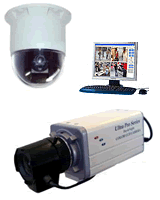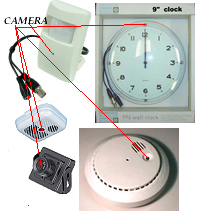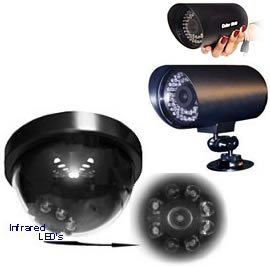 |
 |
Surveillance Cameras & Accessories |
|
IP
based Network Cameras |
|  IP
technology is the next step forward for surveillance systems. IP-based
streaming video surveillance lets organizations monitor, prevent
and/or respond to emergency situations more effectively and affordably,
via the Internet. At the same time, the technology allows law enforcement,
security companies and other emergency personnel to prepare better
and respond more fully to emergencies. Thus, the physical safety
of a company's vital human and business assets is far more secure
and protected. IP
technology is the next step forward for surveillance systems. IP-based
streaming video surveillance lets organizations monitor, prevent
and/or respond to emergency situations more effectively and affordably,
via the Internet. At the same time, the technology allows law enforcement,
security companies and other emergency personnel to prepare better
and respond more fully to emergencies. Thus, the physical safety
of a company's vital human and business assets is far more secure
and protected.
Network security cameras come in different shapes and sizes from
various manufacturers with in-built micro-computer systems and network
interface cards (NICs) for LAN/WAN connections over Ethernet or
Fiber Optics and Wireless communications. This makes access to stored
video and live offsite and internet viewing control and playback
of events possible via a web browser and/or licensed software. They
perform motion detection, alarm management and can be configured
for FTP, HTTP, PPPoE. Some network cameras are built with power
over ethernet capabilities, thus reducing cabling expenses and wiring
incoveniences. Choice of lenses is almost unlimited even as HDD
or network recording of video and audio are all enabled. The major
technical concern with these cameras is bandwidth consideration.
Simply connect network cameras in any combination to your network
via RJ-45 and CAT5 or CAT6 cable and you can view anything or event
from anywhere on earth. |
Non-IP
Cameras |
|  Non-IP
cameras are either digital or analogue cameras without any in-built
computing or network capabilities. They require VCR or DVR recording
and BNC connections over coaxial cables and are best suited for
local monitoring only. It suffices to mention here that coaxial
cabling can go as far as 457 meters before requiring amplification
whereas IP cameras can not go beyond 100 meters at a stretch using
CAT5 cabling,a feture that makes non-IP cameras ideal for most local
surveillance. Non-IP
cameras are either digital or analogue cameras without any in-built
computing or network capabilities. They require VCR or DVR recording
and BNC connections over coaxial cables and are best suited for
local monitoring only. It suffices to mention here that coaxial
cabling can go as far as 457 meters before requiring amplification
whereas IP cameras can not go beyond 100 meters at a stretch using
CAT5 cabling,a feture that makes non-IP cameras ideal for most local
surveillance.
The traditional CCTV and covert/hidden systems use these non-IP
cameras. Current technologies have, hoever, made it possible to
integrate CCTV into IP-based network at low prices. Here
is how... |
Covert/Hidden
Cameras |
 Covert
cameras, as the name suggests, are spy security cameras hidden in
various containers primarily designed for other sues or applications
such as wall clocks, smoke detectors, alarm systems, etc. The intention
is to make the camera invisible so that people are not aware of
their existence and location. Covert
cameras, as the name suggests, are spy security cameras hidden in
various containers primarily designed for other sues or applications
such as wall clocks, smoke detectors, alarm systems, etc. The intention
is to make the camera invisible so that people are not aware of
their existence and location.
Covert cameras require BNC connections over coaxial cabling, although
wireless covert cameras are becoming popular. They may be connected
to a DVR or video servers to achieve IP-based surveillance. Covert
cameras are low cost and easy to deploy.
They are well suited for ATM machines and banking premises, shopping
areas, access control, armed attack prone environments and other
areas where covert application is required, subject to local legislations. |
Day
& Night Infrared Cameras |
|
 Infrared
(IR) cameras, which also come in various shapes and capabilities,are
designed for applications with low-light or no-light requirements.
These cameras (overt and covert) use passive infrared illumination
which are invisible to the human eye to stream videos over BNC,
CAT5/6 and even wireless connections. Thus, an IR camera might be
monitoring an area in low or no-light condition without an intruder's
awareness. Infrared
(IR) cameras, which also come in various shapes and capabilities,are
designed for applications with low-light or no-light requirements.
These cameras (overt and covert) use passive infrared illumination
which are invisible to the human eye to stream videos over BNC,
CAT5/6 and even wireless connections. Thus, an IR camera might be
monitoring an area in low or no-light condition without an intruder's
awareness.
Application areas include oil & gas pipeline monitoring, night
outdoors surveillance and any other application where constant sufficient
lighting can not be guaranteed. |
 |
Star News |
|
|  Thanks
to Camera Servers and Network DVRs, your analogue CCTV can now be
converted to an online real-time digital system Thanks
to Camera Servers and Network DVRs, your analogue CCTV can now be
converted to an online real-time digital system
It's true! Don't condemn your analogue CCTV system
as the advent of Network DVRs, DVR cards and Camera Servers now
make off-site (on-line real-time) monitoring possible with your
analogue cameras.
Read More
|
 |
 Send
and Receive Video Signals Over Electrical Cabling Send
and Receive Video Signals Over Electrical Cabling
With the aid of video signal transmitters and decoders,
video feeds from surveillance cameras may now be received on monitors,
VCRs, DVRs as well as other video devices over your conventional
electrical wiring. No more drilling and laying of video cables.
Read More
|
|
 |
